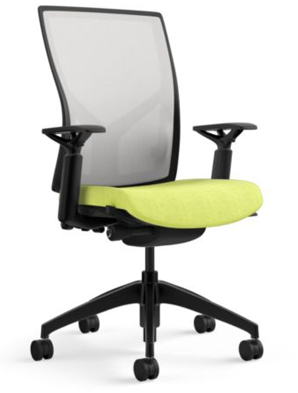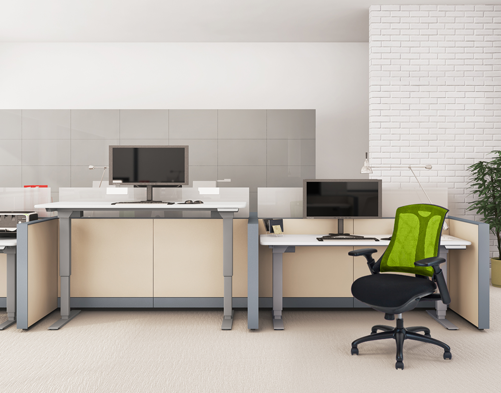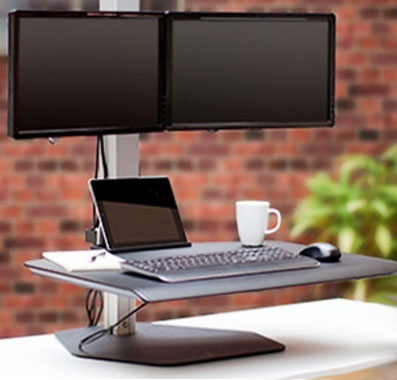When it comes to designing and working in productive office spaces, it’s important to know that many business owners are now placing focus on ergonomics. Having an ergonomic workspace can help to prevent injuries and fatigue, as well as improve the quality of workflow and employee productivity. Creating these environments successfully involves planning a space that makes use of ergonomic office furniture and complementing this with promoting a company culture that appreciates employee health and well-being. Here are our top five tips on creating a productive, ergonomic-friendly workspace:
#1 – Posture & Office Chairs
What types of chairs does your office use? A good office chair will encourage quality posture. If your workplace has older style chairs or those that don’t allow you to sit with your elbows at a 90° angle and your knees at a 90° angle with good sitting posture throughout the day, it’s possible that you can start to feel more fatigued at work, which will slow down your working efficiency. Adjusting your chair height and posture settings, implementing ergonomic best practices, creates a healthier and more productive work space.

#2 – Ergonomic Arm Rests
Arm rests can be extremely crucial to reducing strain on everything from your wrists and shoulders to your spine, hip, and thighs—and once exclusive to executive chairs and high-end specialty models, the growing respect for ergonomics has lead to increased popularity in extending these support features to all employees. Being able to properly support hands and wrists reduces discomfort, contributes to employee health, and can minimize workplace distractions stemming from posture-related fatigue.
#3 – Proper Desk Height
 Certain styles of desks simply aren’t conducive to long working days. Many offices are now acknowledging the benefits of improving employee health and well-being, and an important step they’re taking is to invest in ergonomic office desks. Popular options include leveraging height adjustable desks so that employees can work in the greatest level of comfort—with some desks even allowing employees the opportunity to switch between sitting and standing.
Certain styles of desks simply aren’t conducive to long working days. Many offices are now acknowledging the benefits of improving employee health and well-being, and an important step they’re taking is to invest in ergonomic office desks. Popular options include leveraging height adjustable desks so that employees can work in the greatest level of comfort—with some desks even allowing employees the opportunity to switch between sitting and standing.
#4 – Optimal Computer Screen Height
 The area of vision that you use every day is also extremely important to ergonomics; so, it’s important to ensure proper height of your computer screen/work terminal. Ergonomically focused workplaces have height adjustable monitors and workspaces that can be adjusted for personal comfort. Not adjusting for vision can have both short-term and long-term effects, with some of the most common side effects being headaches and pain in both the neck and shoulders.
The area of vision that you use every day is also extremely important to ergonomics; so, it’s important to ensure proper height of your computer screen/work terminal. Ergonomically focused workplaces have height adjustable monitors and workspaces that can be adjusted for personal comfort. Not adjusting for vision can have both short-term and long-term effects, with some of the most common side effects being headaches and pain in both the neck and shoulders.
#5 – Taking Breaks
 Short breaks can improve productivity in the workplace—with the actual recommendation being to take a 5-10 minute break each hour. The ability to get up and move around your workspace provides an opportunity to stretch and return with renewed energy. Ergonomic-focused workplaces allow employees to get up and walk around throughout the day because they know the dangers of extended sitting, including both physical ailments (muscle aches, eye strain, stress, etc.) and workplace efficiency.
Short breaks can improve productivity in the workplace—with the actual recommendation being to take a 5-10 minute break each hour. The ability to get up and move around your workspace provides an opportunity to stretch and return with renewed energy. Ergonomic-focused workplaces allow employees to get up and walk around throughout the day because they know the dangers of extended sitting, including both physical ailments (muscle aches, eye strain, stress, etc.) and workplace efficiency.
These are a few tips to creating an ergonomic-friendly workspace, addressing factors that can impact both employee performance and health.
